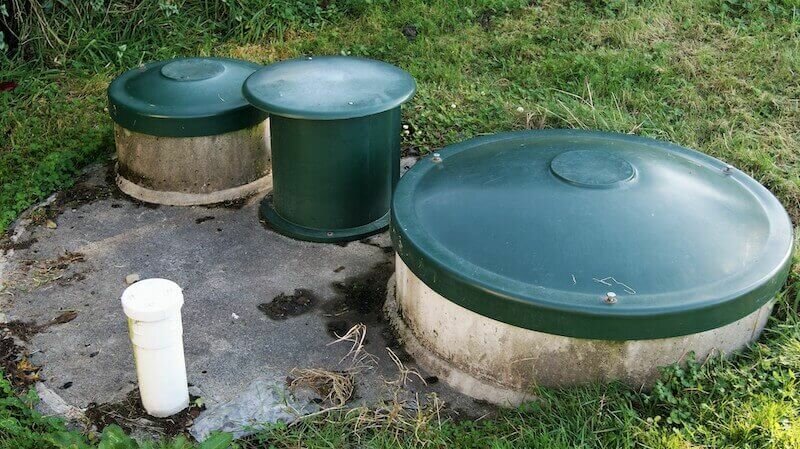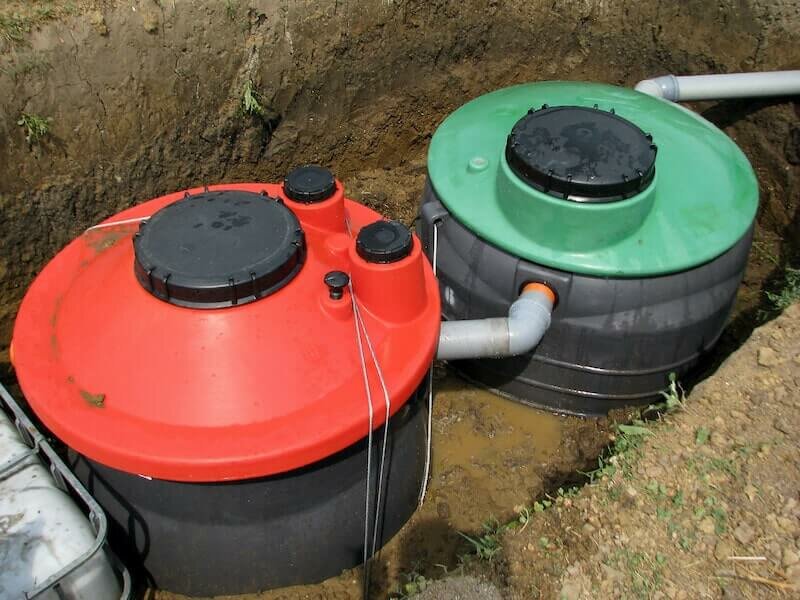Installing a septic system is a great way to treat wastewater from a house, especially if you’re in a rural area or otherwise have no access to a bigger sewer system. However, how much does a septic tank cost to install, and how might that price range affect your decisions?
In this guide, we’ll look at the national average for installing a septic tank, what septic tank size might make sense for you, common types of septic tanks, and more information on things like the replacement cost for an old system. Actual prices will vary by area, but most people will pay close to the prices below.

Why Your Home Needs a Septic Tank
Every home needs a way to deal with wastewater from bathing, cleaning dishes, and plumbing systems. Without an adequate disposal method, you have a significantly higher risk of lowering your lifespan through disease – and that’s not even considering the smell of liquid waste!
Without actual disposal, all the chemicals and bacteria will usually rise to the surface of an area. Furthermore, local issues like a high water table can make it illegal to simply pump out waste without a disposal method.
Septic tanks are usually the best on-site alternative when you don’t have access to a sewer line. A typical septic tank is essentially a high-end filtration system that lets clean water move into the ground while trapping waste and chemicals inside a sealed chamber system.
Although often considered older technology, the truth is that modern septic tanks are a highly effective way of managing waste and it’s possible to install them in most areas. Without a way to dispose of solid waste otherwise, you may not even be able to build or buy a house.
Septic tanks may also be a good choice for selling houses with foundation problems. In these cases, a well-made septic system can help drain water from the area and reduce problems.
Finally, while septic tanks tend to have a high upfront cost, this is mitigated by the fact that you’ll generally have no sewer bill. New homes have both a sewer hookup cost and an ongoing monthly bill, so the two are closer in price than you might expect.
When Else Might Adding A Septic Tank Be Helpful?
There are some cases when adding a septic tank can be helpful for a home. For example, companies that buy houses Idaho residents want may look for newer or high-quality septic tanks to use as a selling point. The same applies to cash home buyers Nampa companies may sell to.
What Size Septic Tank Do You Need
Before talking about any septic system cost considerations, we need to talk about sizes. As you might expect, your septic system cost will vary greatly depending on the size and quality of the tank.
However, tank size alone isn’t enough to decide how big of a system you need. In fact, the tank is usually the easiest part to find space for.
Local regulations may vary, so be sure to check with your town, city, or county to see if things vary. Otherwise, many locations use rules similar to those in New York, which are as follows:
- 1-3 Bedrooms: 1000-gallon capacity, 27 square feet of liquid surface area
- 4 Bedrooms: 1250-gallon capacity, 34 square feet of liquid surface area
- 5 Bedrooms: 1500-gallon capacity, 40 square feet of liquid surface area
- 6 Bedrooms: 1750-gallon capacity, 47 square feet of liquid surface area
For homes larger than this, New York increases the requirements by 250 gallons and 7 square feet of surface area for each additional bedroom. Note that they require installing tanks based on the number of bedrooms in the house, regardless of whether those rooms are occupied.
Florida, which has its own water concerns, uses a different table and evaluates things based on expected water flow per day.
As the chart shows, there are two factors that go into a tank’s size, and that can affect things like your building permits.
The first factor is the overall capacity of your septic system. Most places don’t sell anything smaller than a 1,000-gallon tank for a septic tank system, so don’t expect to see anything below that point. This is the total volume of liquid the tank can hold at once. Remember that septic tanks slowly filter out liquid over time, so having enough capacity is vital.
The second attribute is the liquid surface area. A wider surface area is better because it allows more liquid to filter and flow out of the tank in less time. The most common ratio is about seven square inches of liquid surface area inside the tank for every 250 gallons of storage capacity.
Note that the guidelines above are only the minimum for any house. If you add extensions to your house or invite more people to live with you, you might need a bigger tank. In most cases, there’s no such thing as a septic tank that’s too large. It’s always better to have a larger tank if you can get one.
Outside of the tank itself, you also need a leach field to pass the wastewater through. This may be harder to do in an area with a lot of wetland, so evaluating a property’s unique geography is crucial to figuring out how to install a septic tank system on it.
Finally, remember that you want to maintain access to your tank. Ensuring access will allow a plumber to go inside and fix any clog that may occur. Do not try to DIY a fix for a septic system unless you know exactly what you’re doing, preferably with professional certification.
Septic systems have many complex components, including a baffle to help transport the effluent, some risers, and things that can help when you get your septic tank pumped, and you may void the warranty if you jostle them too much.
Different Types of Septic Tanks
Here are the most common types of septic tanks:
- Concrete: Concrete septic tanks are comfortably durable, usually lasting several decades after installation. However, they can crack, which will lead to groundwater seeping in. That makes them a poorer choice in areas with a lot of rain.
- Fiberglass: Fiberglass septic tanks are generally resistant to cracking and can’t rust, so they’re more than durable enough for most people. However, they can also be prone to shifting if the soil gets too saturated.
- Plastic: Plastic septic tanks are both affordable and durable, cracking less often than concrete. However, it’s easy to damage them while installing them, so many people get fiberglass instead.
- Steel: Steel tanks last for about 25 years, as they’re prone to rust when exposed to water so often. That makes them a rarer choice among buyers these days.
You may be able to get a tank lid that’s different from your tank material. Some people prefer getting sturdier lids to reduce the chance it will break.
Outside of the tank materials, there are also several types of septic systems to consider.
- Conventional: Conventional systems include a standard septic tank and possibly a distribution box, splitting the wastewater into several lines across a drainfield so it can return to the groundwater.
- Aerobic: An aerobic septic system is similar to a small-scale municipal system, adding oxygen and extra treatment. Although expensive, these require much less space than other systems, making them better for small lots.
- Chamber: Chamber systems are similar to conventional septic systems, but they have special connected chambers in the drainfield instead of gravel. These are easier to install and build, so they’re also more affordable.
- Drip: A drip system differs from a conventional septic system by using a powered pump tank to push water through long drip tubes. You can install these slightly underground levels, making them ideal for landscaping.
- Evapotranspiration: Evapotranspiration systems don’t drain into groundwater. Instead, they evaporate the water into the air. These work best in dry areas with lots of heat, but don’t do well in areas with a lot of rain or snow.
- Mound: Mound systems work well in areas with shallow soil or bedrock, or high groundwater levels. A pump tank pushes water into a raised mound, where it can filter down as normal. A mound septic system works with practically any soil type, but it requires a lot of space and may not work for all properties.
Factors like soil type and soil conditions can impact which tank style and material are appropriate for your area. Your local government may ask you to do soil testing before you install a tank, just to be sure you get the right kind.

The Cost of Installing a Septic Tank
According to HomeAdvisor, a major home improvement services website, most people spend between $10,000 and $25,000 to install a complete septic system. That includes the tank, leach field, pipes, labor, and so on. Installing just a new tank is considerably more affordable.
Factors that affect this price include local labor costs, the quality of the materials, and the system style.
The total cost of installing a complete septic system averaged out over its lifespan and assuming average rates, is somewhat under $50 a month. According to Balancing Everything, the cost ranges for average sewer rates vary wildly, but the median for a sewer line is higher than for a septic tank.
In short, while septic tanks have high up-front costs, they’re often more affordable over time. If you’re asking “how much does a septic tank cost to install in my area?”, consider whether taking out a loan and paying over time will be more affordable.
Septic Tank Costs
Septic tank costs, separate from an entire system, are usually between $2000 and $5000 depending on size, material, and overall quality. Most people need to replace the tank occasionally, but the other parts of a septic system are usually a one-time-only cost.
Most septic tanks will last at least 30 years, and some can last much longer in the right conditions. If you average out the cost over the tank’s lifespan, even a higher-quality septic tank will probably cost less than $15/month.
Final Thoughts
So, how much does a septic tank cost to install? As you saw above, the average cost varies based on factors like whether you’re installing a new septic system or just a new septic tank, and what sort of system and tank you’re getting.
Homeowners can expect installation costs to vary more than the price of materials. Labor costs can vary widely, especially if you need to bring people a long way to work on your property. You may also want to pay for landscaping on top of your septic system, but remember that the tank itself needs to remain accessible.
Finally, remember that you do need to maintain the tank over time. Most tanks need flushing and cleaning every few years, though you can reduce the frequency of this by getting a larger tank.
Not all septic tanks work in all climates, so if you’re unsure which makes sense for your area, talk to a local installation company and ask what they usually recommend. That’s a good place to start looking, even if you don’t ultimately end up getting what they suggest.
We buy houses Boise residents sell with septic systems, so even if you want to sell a house without a Realtor, having a septic system won’t impede that. If you’re curious, contact us today to learn how a septic system can affect the selling price of your home.
